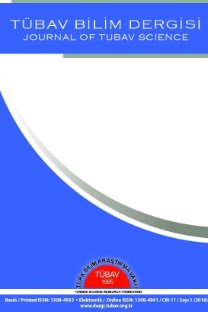Şev Duraylılığı Analizlerinde Limit Denge Yöntemleri, Eurocode 7 ve BS 8006 Sstandartlarıyla Hesaplanan Başarı Oranlarının Karşılaştırılması
Anahtar Kelimeler:
Şev Duraylılığı, Eurocode 7, BS 8006, Kısmi faktörler
Comparison of Success Ratio Calculated Limit Equilibrium Methods for Slope Stability Analyzes, Eurocode 7 and BS8006 Standards
Within the scope of this study, the limit equilibrium methods and Eurocode 7 and BS 8006 standards, which are commonly used in slope stability analysis in our country, have been analysed on the cases which have been well studied in the literature. In order to carried out this comparison, the minimum factor of safety in which the slope is stable within three methods are reduced to a common base. The limit of 1.5 factor of safety accepted for TS 8853 standard is accepted as the limit value for traditional limit equilibrium methods. For Eurocode 7 and BS 8006 standards, this value is accepted as 1. The factor of safety calculated as the result of the analyses are divided by the value determined for each method, and the success rate is obtained, and these values are compared. In addition to limit equilibrium methods, the factor of safety was also analysed by using finite element of shear strength reduction method. As a result of the comparisons, the success rate of traditional limit equilibrium methods in slope stability analysis gives more conservative results. For reinforced slopes and earthing walls, the BS 8006 standard gave more reliable results.
Keywords:
Slope Stability, Eurocode 7, BS 8006, Partial factors,
___
- TERZAGHI, K., and PECK, R.B. 1967. Soil mechanics in engineering practice. (2nd ed.). John Wiley and Sons, Inc., New York, N.Y.WRIGHT, S. 1969. A study of slope stability and the undrained shear strength of clay shales. PhD thesis, University of California, Berkeley, CA.FREDLUND, D. G. 1975. A comprehensive and flexible stability program. Presented at the Roads and Transportation Association of Canada Meeting, Calgary, Alta.NAUGHTON, P., SCUTTO, M., RIMOLDI, P., VICARI, M. 2013. External Stability of Reinforced Soil Walls. Conference: International Symposium on Design and Practice of Geosynthetic-Reinforced Soil Structures- Honouring Research Achievement of Prof. Dov Leshchinsky, At Bologna, Italy.MISIR, G. 2018. Şev Stabilitesi Problemlerinin Sayısal Analizler ile Karşılaştırılmalı Çözümü. DÜMF Mühendislik Dergisi 9:1 (2018).DARYANI, M.B.E., BAHADORI, H., DARYANI, K.E., 2015. Soil Probabilistic Slope Stability Analysis Using Stochastic Finite Difference Method. Doi:10.3233/978-1-61499-580-7-710.Bond A.J., Schuppener B., Scarpelli G., Orr T.L.L, 2013. Eurocode 7: Geotechnical Design Worked Examples, Dublin (Ireland) 13-14 June, 2013. 59-63.Bond, A. and Harris, A. 2008. Decoding Eurocode 7. Taylor & Francis, New York.Simpson, B. , 2011. Concise Eurocodes: Geotechnical design BS EN 1997-1: Eurocode 7, Part 1. BSI, London, UK.EN 1997-1. 2004. Eurocode 7: Geotechnical design - part 1: General rules. European Committee for Standardization, Brussels.CHAN, S.H., YOO, Y.H., LIM, C.S., YAP, K.C., HIEW, L.C., 2017. Assessment of External Stability of Reinforced Soil Wall using British Standard BS 8006 and Eurocode 7. HKIE-IEM-CIE TRIPARTITE SEMINAR.British Standard, BS8006-1, 1995. Code of Practice for Strengthened/Reinforced Soils and Other Fills.Toker, M., Kasım, E. ve Ünlü, G. 2006. “(Elmadag-Kırıkkale) Ayr.- Kalecik Yolu Km:17+200 Heyelanı İyilestirme Projesi Hazırlanması İşi”, 107 s.ŞEKER N.P. 2010. Kırıkkale - Kalecik (Ankara) karayolundaki heyelanın jeoteknik değerlendirmesi. Ankara Üniversitesi Fen Fakültesi Yüksek Lisans Tezi, Ankara.Pilot, G., Trak, B. and La Rochelle, P. (1982). “Effective stress analysis of the stability of embankments on soft soils.” Canadian Geotechnical Journal, vol.19, pp. 433-450. Sheahan, T., and Ho, L. (2003), “Simplified trial wedge method for soil nailed wall analysis.” Journal of Geotechnical and Geoenvironmental Engineering, February 2003, pp. 117-124. Plumelle, C., Schlosser, F., Delage, P., and Knochenmus, G. ~1990!. ‘‘French national research project on soil nailing: Clouterre.’’ Design and performance of earth retaining structures, P. C. Lambe and L. A. Hansen, eds., Geotechnical Special Publication No. 25, ASCE, Reston, Va., 660–675.
- ISSN: 1308-4933
- Başlangıç: 2008
- Yayıncı: TÜRK BİLİM ARAŞTIRMA VAKFI (TÜBAV)
